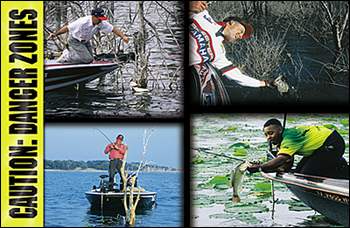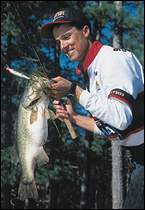
Landing the tough ones isn't as tough a proposition as you might think provided you understand and employ a few basic principles.
By Paul A. Cañada
I remember well, a very hot day in June, when my partner and I were fishing a tournament on tough Richland-Chambers Reservoir near Corsicana. David and I were enjoying an incredible crankbait bite while fishing heavy timber along a submerged road bed at the back of Richland Creek. Admittedly, we weren't threatening to break any lake records, but both livewells were crowded with plenty of keeper fish.
Time was running out and David and I were in dire need of a "kicker"-sized bass. If we had any aspirations of winning the team portion of the tournament, we needed to produce big and in a hurry. Up to that point, the timber lining the roadbed and the adjacent creek had only given up 2- to 3-pounders.
As he had been doing all day, David pitched his lipless crankbait alongside a relatively large tree limb that reached out across the old creek. With less than an hour left in the event, my partner swept his rod back and immediately yelled for a net. The reluctant fish came to the surface, trying with all its might to throw David's Rat-L-Trap.
 The fish was too fresh and too big to rush to the boat. Instead, David used the trolling motor to move the big brawler out over the deeper creek channel. With his rod buried in the water, David drew a series of figure eights with his rod tip. Eventually, he coaxed what we presumed was a spent fish, alongside the boat. The fish was too fresh and too big to rush to the boat. Instead, David used the trolling motor to move the big brawler out over the deeper creek channel. With his rod buried in the water, David drew a series of figure eights with his rod tip. Eventually, he coaxed what we presumed was a spent fish, alongside the boat.
Its energy apparently depleted, David's "kicker" fish began to lazily roll to its side. I slipped the net into the water and watched as David forced the big fish my way. Suddenly, as if it had been playing possum, the 8-plus-pound bass made one last jump. The 2 to 3 feet of line between the fish and David's rod tip was unable to absorb the tremendous weight of the bass and, like a horrible joke, the small treble hook tore free and the much-needed fish was gone.
Later that day, David and I reviewed every moment of that battle. Looking back we agreed that the big fish was lost because of a few minor mistakes made at a critical moment. Today, David and I are better anglers because of that big fish and the lesson it imparted.
If you fish often, it's a good bet that you have suffered similar losses. Even the best anglers lose big fish. However, by paying close attention to detail and demonstrating plenty of patience, professional anglers like Mike Auten, Dennis Canada and Brian Duplechain greatly increase their odds of successfully landing big fish.
More importantly, the three pros believe that what works for them can work for you.
Pregame Check
Arguably, more trophy-sized fish are lost because of equipment failure. A malfunctioning drag, frayed line or poorly tied knot are some of the more common reasons big fish are unexpectedly lost. No matter what the cause, the pain of losing a big fish to equipment failure is surely the toughest to swallow, mostly because equipment failures are preventable.
Professional anglers will tell you that equipment failure should never be the cause for lost fish. They agree that before ever casting a lure, an angler should thoroughly check rods, reels, line and hooks. Lake Fork guide Brian Duplechain considers it "loss prevention."
"The first thing I do before every trip," explains Duplechain, "is tie all my customers' baits on in the morning. Doing this, I am able to check the condition of their fishing line. The second thing I do is check the drag of their reels by pulling line off the spool."
Duplechain says that many of his customers fish only once a month at best. When rods and reels sit for long periods of time the line often goes bad and the drags will stick. In order to minimize the chances of a lifetime fish being lost, Duplechain thoroughly checks his client's equipment before hitting the water.
Additionally, Duplechain monitors his client's line and hooks throughout the day. "When you're fishing around timber and hydrilla," he stresses, "it's very important that you check the first 2 or 3 feet of line for abrasions and nicks, as often as possible. Also, it's a good idea to retie knots and check hooks for sharpness after every fish."
continued
page 1 / page 2
| 




